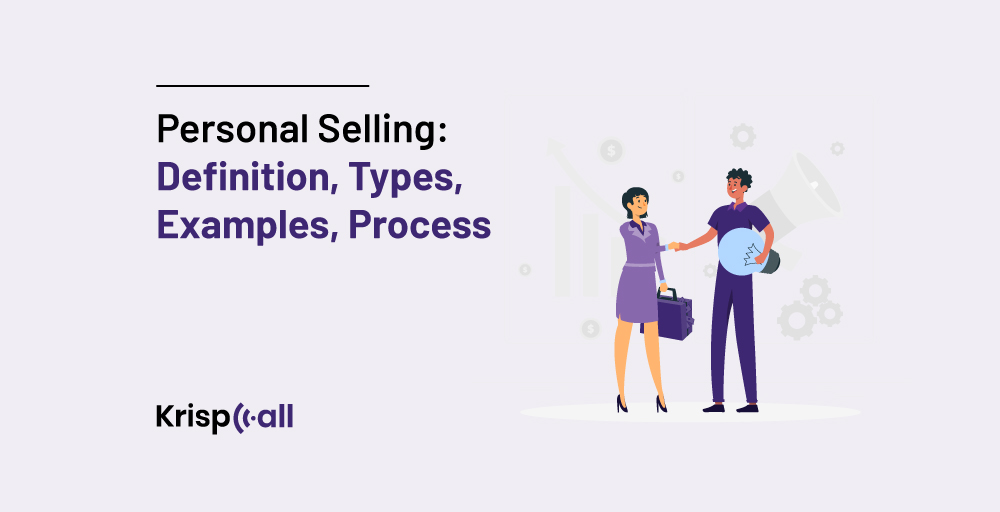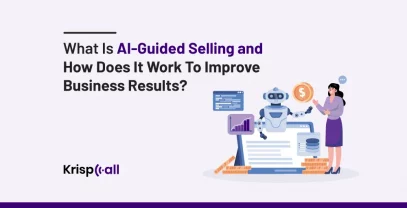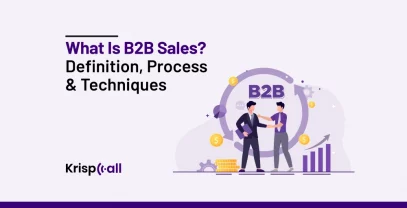Personal selling is one of the most important selling techniques because people are unlikely to establish business with persons or organizations they do not recognize, like, or trust! 🤝
Therefore, it is imperative to agree that personal selling is one of the fundamental functions that no single effective salesperson can overlook👀 and is one of the skills that cannot be overemphasized and must be inculcated into any successful performer at any given time. 💼
In this blog, we are going to talk about what personal selling is, its types, why it is important📊, personal selling techniques👥, the personal selling process, and many more.
🔑 KEY HIGHLIGHTS
- Personal selling is a very engaging form of selling that involves the salesperson communicating with the prospect in person, usually in an informal way.
- Retail Sales, Business-to-Business Sales, Telemarketing, Direct Selling, and Consultative Selling are all types of Personal Selling.
- Customization, Relationship-building, and Immediate feedback are some of the advantages of Personal Selling.
- High cost, Limited reach, and Inconsistent Quality are some of the disadvantages of Personal Selling.
What is Personal Selling?
Personal selling is a marketing technique in which a salesperson directly influences the buyer to purchase a product through a face-to-face conversation. It not only builds rapport but also results in customer loyalty and trust development and helps in the brand-building process.

Moreover, this method normally involves the display of the product to the customers and even making some samples available for use. Acquiring feedback during these exchanges is also helpful in making changes to the products and even selling techniques.
Personal selling is most commonly seen in real estate sales, where real estate agents facilitate personal selling by identifying potential home buyers, getting to know them, and presenting to them suitable homes to be sold, the contracting involved, and the final agreements, which are the selling.
📖 Also Read: SPIN Selling: A Complete Guide
Types of Personal Selling
Personal selling has a diverse range of approaches, each with its unique characteristics and goals. Some of the most prevalent forms of personal selling include:
1. Retail sales
Personal selling is often undertaken in the retail scenario, wherein professional salespersons personally deal with customers in shops or through online portals. Some of their tasks include informing the customer about the benefits of a certain product and its characteristics, answering questions, and making a deal.
Some examples of the scope of retail selling are the workers selling clothes in a dress, electronics items, and those selling cars in an automobile showroom.
2. Business-to-business sales (B2B)
In the context of business-to-business selling, the development of long selling and working close kinship with organizational customers is imperative to selling high volume requirements and generating repeat patronage.
B2B sales, also known as business-to-business sales, are the sales of goods and services meant to be used for business purposes.
3. Telemarketing
Telemarketing, also a form of remote selling, involves selling products and services by informing a prospect, for whom the salesperson works directly on a telephone line, and persuading the prospect to buy his/her company’s product.
This is often adopted to sell tangible items like credit cards, insurance policies, and subscription services through customer telephone calls.
4. Direct selling
Direct selling can also be referred to when sales representatives are selling their products or services in the homes of the consumers. In most cases, it is up to the salesperson to present the product to the buyer, to inform the buyer about the benefits of the product, and to help the buyer place an order.
Examples of direct selling include a salesperson selling seething cosmetics, kitchen utensils, or cleaning accessories directly to clients in their homes.
5. Consultative selling
Consultative selling refers to a more personal and buyer-oriented sales technique that proposes to analyze the buyer’s situation and needs, and then to offer materials and services that will be valuable to him or her and lead to his or her satisfaction and loyalty.
In consultative selling, salespeople adopt the consultative model, which focuses on identifying the customer’s needs and then seeking to offer solutions that address those needs.
Why is Personal Selling Essential?
Personal selling is essential because the salesperson can address a potential buyer using persuasion, with the primary goal of convincing them to buy a product or service or increase revenue through face-to-face interactions.
But contrary to face-to-face communication, which is typical for the process of personal selling, a new approach can be rather successfully applied not only through phone conversations but also through video conferencing and other non-native channels.
Personal selling is an essential tool in developing customer relations, gaining trust, and explaining product information. This makes it a crucial aspect of the sales mix, especially in business-to-business and high-involvement situations.
🧐This might interest you: What Is Tech Sales, and How Can You Break Into It
Personal Selling Techniques
Personal selling techniques encompass various strategies that sales representatives use to engage with potential customers and close sales effectively. Some of these are:
1. Focusing on the right leads
Proper prospecting and qualifying enable a company to target the best leads that have great chances of closing the deal, thus utilizing the available time and resources.
When these specifically targeted leads have been identified, the amount and type of information gathered can be used by a potential salesperson to address the issues that the target possesses and, in the latter’s buying process, show the relevance of their products.
Not only it improves the sales presentation and communication with clients but also strengthens the trust with the customers increasing the rates of conversion and loyalty.
2. Exceeding expectations through preparation
To prepare effectively, one needs to analyze potential customers to understand who they are, what their needs and wants are and what issues may arise to make them question your product.
Therefore, having proper information and a broad understanding of the case ahead of time will enable the sales representatives to appeal to the emotions of the customer in great detail. This degree of preparedness is professional and shows a clear intention to be able to address the needs of the customer, which in turn helps to establish trust.
Finally, this extensive procedure not only satisfies the customers’ expectations but frequently surpasses them, contributing to the enhancement of long-term relationships and higher chances of winning the contract.
3. Adding value to the meeting
Personal selling is the actual face-to-face selling process and when powerful techniques are used in that process, this as a whole can add value in meetings. This can also help to set a salesperson and a customer apart from competitors and lead to the formation of stronger customer relations.
When it comes to sales talks, adding value refers to sharing extra information that shall assist the customer other than what is contained in the item being sold or service. This could involve discussing what is happening in the market, recommending changes that will make their business run more efficiently, or showing them how the product can address issues they encounter.
Redoing the plan focusing on the customer’s wider situation allows the salesperson to be seen as much more than a person who sells products. This creates value and trust in the customer because he or she surely believes that the salesperson cares for business to achieve its goals.
4. Make it clear you’re in this together
A very effective power tool in the personal selling context is to convey to the customer that you are on the customer’s side. This is done by highlighting the fact that your objective is the achievement of the customer’s goals and the satisfaction of his or her needs.
That means that by listening to them and making sure that your solutions complement their aims and objectives, you are expressing belief in their success. Asking questions like “What can we do?” instead of “What are you going to do?” is a good example of how sales reps should promote their products to leads.
That is when customers believe that you are interested in their success or when the relationship is based on mutual cooperation, so customers involve themselves in the interaction in a more positive manner leading to the long-term cooperation and thus boosting up the sales.
🤝Dig deeper with this: Sales Engagement Process: What Is It, How It Works, Tips & More
Personal Selling Process
The steps involved in the personal selling process vary depending on the specific sales process. One needs to gain knowledge about these personal selling techniques so as to enhance and make the selling process more efficient.
The following are some of the guidelines that can help the sales professional navigate the customer through the funnel and increase the chances of closing the sale.
1. Prospecting
Starting the process of selling, the salespeople engage in prospecting, where they identify prospective buyers who have a probability of showing interest in the offered product or service.
This first step can be done in various ways, such as using references, cold calling, participating in events, and using social media, among others.
2. Pre-approach
At this stage, sales representatives gather customers’ information, needs, and buying behavior. They also obtain product—or service-related information that provides an overall idea to develop a customer perspective.
Then, suppose the buying criteria match is accurate. In that case, the overall sales approach is then aligned to directly attend to the specific needs and wants of the prospect and, therefore, the message that is developed for the sale is very well suited.
3. Approach
At this point, the sales team proceeds to make the first point of contact either through a warm call, a meeting through any media – virtual or face-to-face, email, or a direct business meeting, which adds up to the first touch.
The aim is to make the first interaction with a customer as close to perfect as possible and make the customer feel as comfortable about doing business with the company as a first step towards developing a healthy business relationship.
4. Presentation
When the friendly factor has been created by the salesperson with the consumer, they will progress to the presentation stage. This means the product or service to be sold is presented to consumers, and an explanation is given on what it is, its uses, and its importance.
The opportunity for such a salesperson may use one or several means of presentation: demonstration, witnesses, or examples that would encourage the purchasing of the product.
5. Overcoming Objections
During the product demonstration, the prospect might voice issues or doubts regarding the product or service. These are issues the salesperson should be prepared to address, proactively offering positive responses that would put the customer’s mind at ease.
It may require providing additional information, recommending specific services, or explaining any misconceptions that the customer may have, which helps the latter to comprehend deeply and eliminate his/her concerns.
5. Closing the deal
The last stage in the personal selling process is the prospect all-encompassing closing, defined as the act of asking the customer for their business and making the sale. By this stage, there should be mutual trust between the salesperson and the customer to ensnarled the ambiance to close the sale.
After the sale has been made, the next best way of maintaining this personal contact and eradicating any suspicion is by follow-up communications and soliciting feedback. This is very important for creating a loyal and satisfied customer who would be willing to do business when ready in the future.
😎 Do you want to automate your sales processes? Read this: What is Sales Automation? A Complete Guide
When Should You Use Personal Selling?
Personal selling, as a sales strategy, can be applied in a wide range of business contexts, yet it tends to yield particularly impressive results in situations where:
- Highly Specialized Offering: Personal selling is a great way to introduce a specialized product because it lets you show and explain how the product is designed to meet your prospect’s specific needs.
- Small Market with a Few Large Buyers: When there are only a few buyers in the market, personal selling is ideal. Your sales reps can visit each buyer directly, give them detailed information about your product, and convince them of its value.
- High-end/complex product: Personal selling helps you let the customers know why they should spend their money in your products instead of going for the products that are being sold in the market at cheaper prices.
- Highly Competitive Market: Due to the very competitive nature of today’s market, it is very important to find some ways to differentiate the product. This can be solved through personal selling.
- Lack of funds for other advertising channels: In cases whereby your company is not very profitable and cannot sponsor television or radio advertisements, then personal selling can be used to promote your products.
Personal Selling Advantages & Disadvantages
Although personal selling has many advantages, it also has some disadvantages. We will list these.
Advantages
- Customization: Personal selling allows you to use the power of customization. For example, a salesman selling office equipment to a firm can determine the company’s unique needs and propose tailored solutions to fulfill those needs.
- Relationship-building: Personal selling allows a financial adviser to establish close relationships with customers by giving individualized financial advice, addressing queries, and displaying a genuine interest in the client’s financial well-being.
- Immediate feedback: A salesperson who is selling a new product can observe the customer’s reactions and adjust their sales pitch accordingly.
Disadvantages
- High cost: Implementing personal selling tactics can be cost-intensive, as illustrated by a company that hires a sales team to peddle industrial machinery to fellow businesses.
- Limited reach: Personal selling may not yield the same extensive reach as other marketing strategies, as demonstrated by a salesperson promoting cosmetics to customers within their residences.
- Inconsistent Quality: Companies that rely on unskilled or inexperienced salespeople to promote their products may face quality and effectiveness difficulties. This can lead to missed sales.
Conclusion
Personal selling is not only effective in creating immediate sales since it also builds long-framed mutual relationships that are crucial for any business to sustain itself in any specific market type/level.
And it is important to realize that personal selling is very much relevant and evolving as part of the overall flow of selling, which is characterized by its face-to-face and interpersonal nature of communication between the salesperson and the customer.
Personal selling comprises transactional, relationship, and consultative selling strategies because of its versatility. The utility of personal selling is that it enables the establishment of a good relationship with the customers, offering a customized solution to the customers’ needs.





